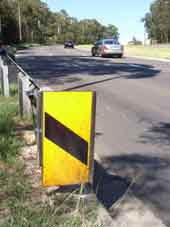Road Furniture

Road furniture refers to all fixtures in the road and road reserve. The term includes fixtures on the road surface such as steel covers and traffic domes (silent cops) or lane markers, all of which can create a hazard for a motorcycle.
Road furniture in the road reserve such as light poles, signposts, bus shelters and crash barriers may cause additional injuries if a motorcyclists is thrown against them as a result of a crash.
Road authorities need to be alerted to the unintentional hazard created by the inappropriate choice or placement of road furniture.
Unlike other motorists, a motorcyclist is not protected within the steel cage of a vehicle. Objects that may be considered frangible (breakable) when struck by a vehicle, are not frangible when hit by a human body.

Crash barriers
Crash barriers are the most contentious form of road furniture. While they do improve safety for most vehicle occupants, they are often an increased risk for motorcyclists. Crash barriers were the point of impact for 15% of riders who died and 5% of those who were injured in single vehicle crashes in NSW.
Wire rope fences are the focus of many rider's fears, although it is the upright posts that are common to many designs that actually cause the most severe injuries.
Recent research comparing concrete and wire rope fences, has found there may be additional risks for motorcyclists associated with wire rope fences. It was found, in simulations, that motorcyclists' extremities became caught between the wires, effectively guiding them into the posts. This snagging effect subjected the motorcycle and rider to large deceleration forces and exposed the rider to higher risk of injury (Berg et al. 2005).
There have been advances in the design of crash barriers to make them less hazardous for motorcyclists. These include covering the tops of posts on W-beam rails, installing additional W- beams to provide a sheer surface to the ground, and covering exposed posts with specifically designed covers to disperse the force of an impact. A number of European countries have standards or guidelines for crash barriers, specifically to reduce the risk of injury to motorcyclists. Barriers to change
Poles and posts
Utility poles and other posts were involved in 14% of crashes and 9% of all motorcycle fatalities.
Fixed objects anywhere in the road environment are a hazard, but light poles and sign posts that are close to the inside of corners create a significant hazard as a rider leans into a corner.
Such hazards seem totally unnecessary and due to ignorance.
 Road engineers need to realize that when a rider leans into a corner, the width of the motorcycles path can increase by about a metre. This means the rider must choose a path that avoids either colliding with objects on the side of the road, or leaning over the centre line into oncoming traffic. The choice is more difficult if the rider also has to negotiate a road surface that is damaged or slippery.
Road engineers need to realize that when a rider leans into a corner, the width of the motorcycles path can increase by about a metre. This means the rider must choose a path that avoids either colliding with objects on the side of the road, or leaning over the centre line into oncoming traffic. The choice is more difficult if the rider also has to negotiate a road surface that is damaged or slippery.
Collisions with road furniture were involved in 55% of all motorcycle fatalities in New South Wales. Approximately 82% of single vehicle motorcycle fatalities involve roadside poles, trees or posts (ATSB, Review of Wire Rope Safety Barriers: Working Party Report, June 2000).
 Road furniture hazards may be created by the use or placement of:
Road furniture hazards may be created by the use or placement of:
- Crash barriers
- Guide posts
- Signs
- Rigid guide posts and protrusions on crash barriers
- Trees
- Traffic domes (silent cops)
- Raised lane markers
- Pavement bars
- Rumble strips
- Steel plates and pit covers
- Rail crossings and tram tracks
- Steel bridge expansion joints.

